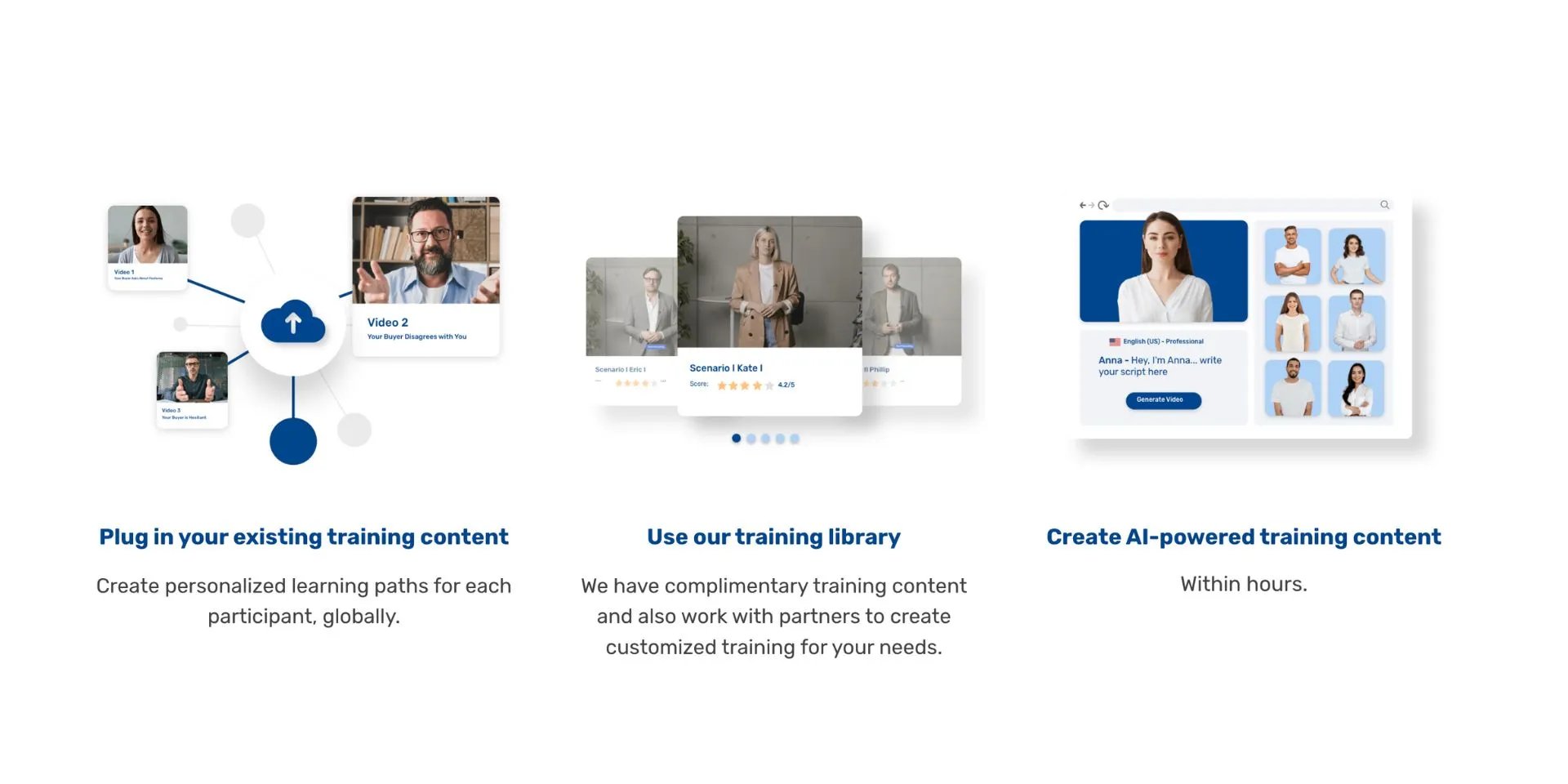One of the pillars of a successful business is a leader's ability to communicate clearly and effectively with employees, within teams, and throughout the organization.
Especially with the hundreds of various communication platforms, completely or partially remote working teams, and even multicultural teams across different time zones, efficient business communication has never become more important.
Consequently, having good communication skills is fast becoming the most essential quality of any manager.
This blog post will delve into the 10 best tips you can implement to improve your communication skills course to enhance the quality of communication and workplace relationships
What's in this post?
What is communication skills training?
Communication skills training helps you and your team in overcoming common barriers to successful communication. It teaches important soft skills such as trust building, speaking with confidence, as well as recognizing and understanding nonverbals.
According to a survey by GMAC Corporate Recruiters, soft skills are the top-rated skills that every company is searching for in new hires. Furthermore, 57% of recruiters believe that the demand for interpersonal skills will continue to rise.
Communication skills training's primary purpose is to provide employees with the necessary tools and strategies needed to communicate more effectively, persuasively, and confidently. It teaches its participants the value of good communication through body language and non-verbal communication.
It encourages teamwork, and developing strong connections with coworkers, clients, and stakeholders.
Why is communication skills training important?
As a career professional, the importance of prioritizing your professional and personal development is important. Therefore, communication training is part of that growth to help you succeed as you gain knowledge on the core skills that will enhance your communication abilities with customers and stakeholders.
According to Harvard Business Review, having emotional connections with customers and clients is an essential component when it comes to "competitive differentiator." Essentially, how you communicate with customers is what distinguishes you as an employee and as a corporation. The better your communication, the better your reputation and brand image will be, leading to more customers wanting to do business with you.
Here are a few more reasons why communication skills training is important:
-
Better customer relationships: Especially in customer-facing roles, being a good communicator is essential for providing excellent customer service. Employees who have strong communication skills will be able to understand customer needs faster, efficiently address concerns, and build the level of trust that customers have for them. This results in gaining happy and loyal customers.
-
Better Client and stakeholder relationships: Maintaining excellent connections with clients, partners, and stakeholders is just as important as maintaining it with customers. Therefore, having effective communication skills enables the growth of these connections, which will lead to successful collaborations and business growth.
-
Enhanced leadership skills: Leaders who are able to communicate well set a strong example for their team. Leadership frequently entails encouraging and motivating teams to achieve their best, setting clear objectives, and delivering constructive feedback. Therefore, communication skills training in leadership is important for leaders to learn how to become more confident and influential.
-
Increased productivity: We all know that nothing good comes out of what happens when there is miscommunication. By investing in communication training, misconceptions can be eliminated, resulting in faster workflows and fewer mistakes. Clear communication ensures that tasks and responsibilities are executed accurately and on schedule which inevitably results in increased productivity when everyone knows what they are doing and how they should be doing it. Having communication training also allows for employees to feel confident in asking better questions which can also prevent misunderstandings and errors in the workplace.
-
Positive workplace environment: Having communication training can result in cultivating a more pleasant and harmonious workplace. When employees take part in communication skills courses, it allows them to feel heard and understood. This increases their job satisfaction and lowers turnover rates in the long run.
Four types of communication skills to include in employee training
There are four main communication techniques that you should include in your communication courses. Here is a closer look at each one of them.
Verbal
Also known as oral communication, verbal communication is when thoughts and ideas are shared through speech. It is the standard type of communication that we all use to communicate with people across the organization. Verbal communication can also be informal when you chat with coworkers about an upcoming task, and it can also be more formal when it takes place in a meeting with your manager when it's time for a performance evaluation.
Non-verbal
Non-verbal comes in the form of body language, eye contact, and an individual's demeanor. You can improve on nonverbal communication skills by employing appropriate facial expressions when talking with a customer or client, nodding to show that you are listening and paying attention, and maintaining good eye contact.
In order for a message to be conveyed clearly, verbal communication and body language usually go in sync.
Written
Writing is a more traditional form of communication that we still use nearly every day in a professional and personal setting. Written communication skills come into play when writing e-mails, and sending messages with tools like Slack or Teams, as well as in more official publications such as project reports and whitepapers.
Written communication requires conveying information professionally, accurately, and with a correct tone of voice to get the message across successfully.
Active listening
In contrast to the other communication styles listed above, having good listening skills is all above knowing how to receive information. When someone is actively listening, they are able to ask better questions to better understand the information that is being shared, yet they should also avoid becoming overly occupied with their response that they fail to hear what the speaker has to say.
Active listening allows for information to be distributed and acquired efficiently and for the flow of the other communication techniques to follow suit.

Tips to improve communication skills training
When searching for communications courses, you will find plenty of them showing you how you should train to improve your communication skills, but what about how you can improve on them to make it even more efficient than before? Let's have a look at the 10 things you can do to boost your training experience.
Build on emotional intelligence
Emotional intelligence (EQ) is the ability to understand and manage one's own emotions as well as the emotions of others. Having emotional intelligence as a skill includes being able to be empathetic and understand our own emotions as well as how others are feeling in order to communicate effectively. Here are some ways that you can build emotional intelligence to improve communication skills training:
-
Help employees develop a better sense of self-awareness. Encourage them to recognize their emotions when they are calm, frustrated, or stressed and how their communication patterns change according to each emotion.
-
Teach employees to recognize the emotions of others. This includes being aware of non-verbal cues such as a person's body language, and tone of voice. Knowing this skill is important for understanding the emotional context of a conversation and finding ways to navigate it well.
-
Focus on emotion regulation techniques. This is crucial when employees have to face high-pressure situations. Teach them strategies like deep breathing and stress management to help employees stay calm and respond sensibly rather than acting out of heightened emotions, especially regarding customer service.
Interactive activities and workshops
One of the best ways to improve your communication skills training program is to incorporate communication-building activities that will help build teamwork and also get employees to learn about their communication style as well as other people's way of communicating.
This way, employees will be able to get used to interacting with different types of communication and practice their communication skills in a safe and supportive environment. Some examples of interactive activities include role-play, group discussions, and practical exercises.
Practice active listening
Effective communication, as mentioned before, involves only being able to articulate your words well, but it is also actively listening to what someone has to say. Not only does doing so show respect for other team members, but it also trains employees to obtain and understand the information that is verbally shared with them well and comprehensively to avoid misunderstanding and potential errors.
A training example for practicing active listening:
-
Divide employees into groups of four to six people, depending on how many employees are participating.
-
Prepare a scenario or a topic of discussion that is related to a workplace challenge, an issue with a customer, or a misunderstanding/explanation of a task.
-
Provide an "Active listening guideline" for employees to look into which includes a note of important communication skills such as maintaining good eye contact with the speaker, and showing non-verbal cues as a form of understanding.
-
Assign roles - one person is the speaker who will share their concerns, thoughts, and experiences, while the others take on the role of the active listener (s). Their role is to listen to what the speaker has to say without any interruption.
-
Once the first round is over, have employees switch positions until each employee has had the chance to be both an active listener and speaker.
-
Once the activity is over, encourage employees to share their observations and insights about the activity and what they have learned.
Cultural sensitivity training
When having a diverse workforce, it is important to include cultural sensitivity and diversity training if you don't already have it.
A cultural sensitivity training will help employees to better understand and respect cultural differences when it comes to communication styles, and learn more about how they can communicate respectfully and effectively with other cultures.
Moreover, incorporating cultural sensitivity training will help to minimize misunderstandings and disputes when employees learn how to recognize and appreciate cultural differences in the workplace.
Create personalized training
If you don't already personalize your training programs to each individual, now is the time to do so! A one-size-fits-all training strategy is unlikely to be effective as no one is the same and everyone learns differently.
Personalized training allows for each individual to learn skills at their own pace and have their own learning path. This personalized learning path will also allow them to receive tailored feedback that applies to their personal progress. Therefore, it is vital to customize your training program to your employee's needs and skill levels.
That way, employees will be able to improve their communication skills if they are able to get feedback and recommended exercises based on their own performance rather than a generalized one.
Real-life scenarios training
What better way to improve communication training than to be immersed in different real-life situations and be trained to handle each scenario successfully? This form of training can take place with an AI-powered training program that shows, for example, various kinds of customers reacting and responding differently. This allows employees to apply what they're learning to real-life scenarios that they can face on a daily basis.
Incorporate feedback
Constructive feedback should be given to employees during and after training sessions. Giving feedback is also a useful communication skills practice for both the feedback provider and feedback receiver: listen attentively, allow space for questions to be asked, and provide clear answers.
Encourage employees to also express their ideas and concerns regarding their job, and provide personalized feedback to help them improve. Feedback is a key part of any training and development program as it also creates a two-way dialogue between the manager and employee and strengthens the relationship and communication between them.
Measure effectiveness
To improve your communication skills training, you must regularly evaluate the success of it. See what is doing well and what could be improved on to generate more success in skill development.
To do this, you can collect information on employee satisfaction, their skill development (how many skills they have learned and how far they've improved), and the influence it has made on workplace communication.
Use this data to make the necessary changes and adjustments to create a high-quality communication training program that delivers better performance outcomes.
Celebrate achievements
Recognize and celebrate the accomplishments that each employee has earned in the development of their communication skills. When an employee's achievements are acknowledged, it shows that the company cares and values their employee's growth and increases employee happiness.
Recognize and share the success stories of employees who have made significant improvements. This can positively motivate other employees to improve their communication skills as well.
Create a mindset of continuous learning and improvement
Communication skills training is an ongoing process and should be practiced on a regular basis to maintain efficiency. It does not just end after every course.
Encourage employees to acquire a mindset of continuous learning and improvement when it comes to developing skills and encourage them to practice their communication skills outside of the training programs as well. To help them in their development, you can provide them with extra material such as online courses, books, or coaching.
Communication skills training lays a strong foundation for a well-performing organization. After all, investing in your company's greatest assets (aka your employees) will boost company success and create long-lasting, happy workers. What more could you ask for?
When it comes to training, Retorio has got you covered. Retorio's behavioral intelligence platform features AI-powered video simulations that immerse you into various job situations, train you to practice real-life customer conversations, and enhance your interpersonal skills.
Or better - create your own training in less than a day, measure & maximize the ROI of your existing learning content, and create personalized learning paths for each participant.

Sounds good, doesn't it? Click on the button below to get started right away!
FAQ
Active listening, giving and receiving feedback, having empathy and respect for others, responding to messages and e-mails clearly and politely, understanding non-verbal cues, building friendliness and confidence in the workplace, and adapting your communication style according to the audience you are faced with are all examples of having effective communication.
Companies can collect data through employee surveys, interviews, feedback from performance reviews, observations, employee assessments, or reports. However, in order to analyze the data to measure the effectiveness, compare the actual outcome of the training program to the estimated results, and find the gaps, strengths, weaknesses, opportunities, and threats in your communication training strategy.



